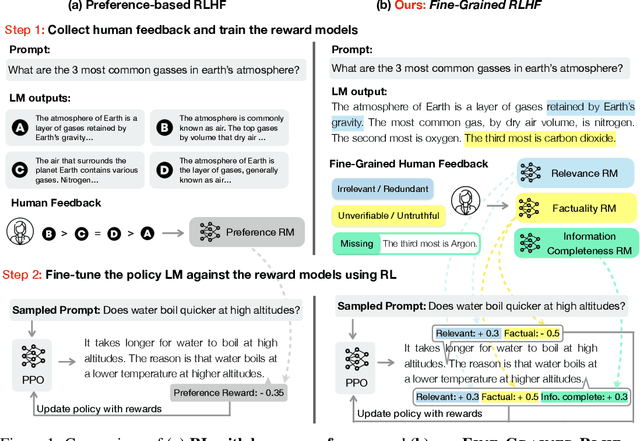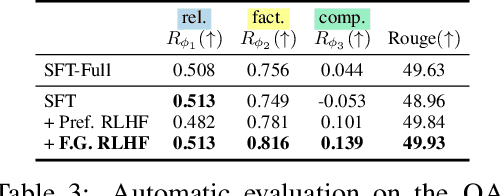Prithviraj Ammanabrolu
Beyond Needle(s) in the Embodied Haystack: Environment, Architecture, and Training Considerations for Long Context Reasoning
May 22, 2025Abstract:We introduce $\infty$-THOR, a new framework for long-horizon embodied tasks that advances long-context understanding in embodied AI. $\infty$-THOR provides: (1) a generation framework for synthesizing scalable, reproducible, and unlimited long-horizon trajectories; (2) a novel embodied QA task, Needle(s) in the Embodied Haystack, where multiple scattered clues across extended trajectories test agents' long-context reasoning ability; and (3) a long-horizon dataset and benchmark suite featuring complex tasks that span hundreds of environment steps, each paired with ground-truth action sequences. To enable this capability, we explore architectural adaptations, including interleaved Goal-State-Action modeling, context extension techniques, and Context Parallelism, to equip LLM-based agents for extreme long-context reasoning and interaction. Experimental results and analyses highlight the challenges posed by our benchmark and provide insights into training strategies and model behaviors under long-horizon conditions. Our work provides a foundation for the next generation of embodied AI systems capable of robust, long-term reasoning and planning.
Collaborating Action by Action: A Multi-agent LLM Framework for Embodied Reasoning
Apr 24, 2025Abstract:Collaboration is ubiquitous and essential in day-to-day life -- from exchanging ideas, to delegating tasks, to generating plans together. This work studies how LLMs can adaptively collaborate to perform complex embodied reasoning tasks. To this end we introduce MINDcraft, an easily extensible platform built to enable LLM agents to control characters in the open-world game of Minecraft; and MineCollab, a benchmark to test the different dimensions of embodied and collaborative reasoning. An experimental study finds that the primary bottleneck in collaborating effectively for current state-of-the-art agents is efficient natural language communication, with agent performance dropping as much as 15% when they are required to communicate detailed task completion plans. We conclude that existing LLM agents are ill-optimized for multi-agent collaboration, especially in embodied scenarios, and highlight the need to employ methods beyond in-context and imitation learning. Our website can be found here: https://mindcraft-minecollab.github.io/
TALES: Text Adventure Learning Environment Suite
Apr 22, 2025Abstract:Reasoning is an essential skill to enable Large Language Models (LLMs) to interact with the world. As tasks become more complex, they demand increasingly sophisticated and diverse reasoning capabilities for sequential decision-making, requiring structured reasoning over the context history to determine the next best action. We introduce TALES, a diverse collection of synthetic and human-written text-adventure games designed to challenge and evaluate diverse reasoning capabilities. We present results over a range of LLMs, open- and closed-weights, performing a qualitative analysis on the top performing models. Despite an impressive showing on synthetic games, even the top LLM-driven agents fail to achieve 15% on games designed for human enjoyment. Code and visualization of the experiments can be found at https://microsoft.github.io/tales.
In-context Ranking Preference Optimization
Apr 21, 2025Abstract:Recent developments in Direct Preference Optimization (DPO) allow large language models (LLMs) to function as implicit ranking models by maximizing the margin between preferred and non-preferred responses. In practice, user feedback on such lists typically involves identifying a few relevant items in context rather than providing detailed pairwise comparisons for every possible item pair. Moreover, many complex information retrieval tasks, such as conversational agents and summarization systems, critically depend on ranking the highest-quality outputs at the top, emphasizing the need to support natural and flexible forms of user feedback. To address the challenge of limited and sparse pairwise feedback in the in-context setting, we propose an In-context Ranking Preference Optimization (IRPO) framework that directly optimizes LLMs based on ranking lists constructed during inference. To further capture flexible forms of feedback, IRPO extends the DPO objective by incorporating both the relevance of items and their positions in the list. Modeling these aspects jointly is non-trivial, as ranking metrics are inherently discrete and non-differentiable, making direct optimization difficult. To overcome this, IRPO introduces a differentiable objective based on positional aggregation of pairwise item preferences, enabling effective gradient-based optimization of discrete ranking metrics. We further provide theoretical insights showing that IRPO (i) automatically emphasizes items with greater disagreement between the model and the reference ranking, and (ii) links its gradient to an importance sampling estimator, yielding an unbiased estimator with reduced variance. Empirical results show IRPO outperforms standard DPO approaches in ranking performance, highlighting its effectiveness in aligning LLMs with direct in-context ranking preferences.
A Survey on Personalized and Pluralistic Preference Alignment in Large Language Models
Apr 09, 2025Abstract:Personalized preference alignment for large language models (LLMs), the process of tailoring LLMs to individual users' preferences, is an emerging research direction spanning the area of NLP and personalization. In this survey, we present an analysis of works on personalized alignment and modeling for LLMs. We introduce a taxonomy of preference alignment techniques, including training time, inference time, and additionally, user-modeling based methods. We provide analysis and discussion on the strengths and limitations of each group of techniques and then cover evaluation, benchmarks, as well as open problems in the field.
Critique-out-Loud Reward Models
Aug 21, 2024Abstract:Traditionally, reward models used for reinforcement learning from human feedback (RLHF) are trained to directly predict preference scores without leveraging the generation capabilities of the underlying large language model (LLM). This limits the capabilities of reward models as they must reason implicitly about the quality of a response, i.e., preference modeling must be performed in a single forward pass through the model. To enable reward models to reason explicitly about the quality of a response, we introduce Critique-out-Loud (CLoud) reward models. CLoud reward models operate by first generating a natural language critique of the assistant's response that is then used to predict a scalar reward for the quality of the response. We demonstrate the success of CLoud reward models for both Llama-3-8B and 70B base models: compared to classic reward models CLoud reward models improve pairwise preference classification accuracy on RewardBench by 4.65 and 5.84 percentage points for the 8B and 70B base models respectively. Furthermore, CLoud reward models lead to a Pareto improvement for win rate on ArenaHard when used as the scoring model for Best-of-N. Finally, we explore how to exploit the dynamic inference compute capabilities of CLoud reward models by performing self-consistency decoding for reward prediction.
Personalized Soups: Personalized Large Language Model Alignment via Post-hoc Parameter Merging
Oct 17, 2023Abstract:While Reinforcement Learning from Human Feedback (RLHF) aligns Large Language Models (LLMs) with general, aggregate human preferences, it is suboptimal for learning diverse, individual perspectives. In this work, we study Reinforcement Learning from Personalized Human Feedback (RLPHF) problem, wherein LLMs are aligned to multiple (sometimes conflicting) preferences by modeling alignment as a Multi-Objective Reinforcement Learning (MORL) problem. Compared to strong single-objective baselines, we show that we can achieve personalized alignment by decomposing preferences into multiple dimensions. These dimensions are defined based on personalizations that are declared as desirable by the user. In this work, we show that they can be efficiently trained independently in a distributed manner and combined effectively post-hoc through parameter merging. The code is available at https://github.com/joeljang/RLPHF.
Fine-Grained Human Feedback Gives Better Rewards for Language Model Training
Jun 02, 2023



Abstract:Language models (LMs) often exhibit undesirable text generation behaviors, including generating false, toxic, or irrelevant outputs. Reinforcement learning from human feedback (RLHF) - where human preference judgments on LM outputs are transformed into a learning signal - has recently shown promise in addressing these issues. However, such holistic feedback conveys limited information on long text outputs; it does not indicate which aspects of the outputs influenced user preference; e.g., which parts contain what type(s) of errors. In this paper, we use fine-grained human feedback (e.g., which sentence is false, which sub-sentence is irrelevant) as an explicit training signal. We introduce Fine-Grained RLHF, a framework that enables training and learning from reward functions that are fine-grained in two respects: (1) density, providing a reward after every segment (e.g., a sentence) is generated; and (2) incorporating multiple reward models associated with different feedback types (e.g., factual incorrectness, irrelevance, and information incompleteness). We conduct experiments on detoxification and long-form question answering to illustrate how learning with such reward functions leads to improved performance, supported by both automatic and human evaluation. Additionally, we show that LM behaviors can be customized using different combinations of fine-grained reward models. We release all data, collected human feedback, and codes at https://FineGrainedRLHF.github.io.
SwiftSage: A Generative Agent with Fast and Slow Thinking for Complex Interactive Tasks
May 27, 2023Abstract:We introduce SwiftSage, a novel agent framework inspired by the dual-process theory of human cognition, designed to excel in action planning for complex interactive reasoning tasks. SwiftSage integrates the strengths of behavior cloning and prompting large language models (LLMs) to enhance task completion performance. The framework comprises two primary modules: the Swift module, representing fast and intuitive thinking, and the Sage module, emulating deliberate thought processes. The Swift module is a small encoder-decoder LM fine-tuned on the oracle agent's action trajectories, while the Sage module employs LLMs such as GPT-4 for subgoal planning and grounding. We develop a heuristic method to harmoniously integrate the two modules, resulting in a more efficient and robust problem-solving process. In 30 tasks from the ScienceWorld benchmark, SwiftSage significantly outperforms other methods such as SayCan, ReAct, and Reflexion, demonstrating its effectiveness in solving complex real-world tasks.
Inference-Time Policy Adapters (IPA): Tailoring Extreme-Scale LMs without Fine-tuning
May 24, 2023Abstract:Large language models excel at a variety of language tasks when prompted with examples or instructions. Yet controlling these models through prompting alone is limited. Tailoring language models through fine-tuning (e.g., via reinforcement learning) can be effective, but it is expensive and requires model access. We propose Inference-time Policy Adapters (IPA), which efficiently tailors a language model such as GPT-3 without fine-tuning it. IPA guides a large base model during decoding time through a lightweight policy adaptor trained to optimize an arbitrary user objective with reinforcement learning. On five challenging text generation tasks, such as toxicity reduction and open-domain generation, IPA consistently brings significant improvements over off-the-shelf language models. It outperforms competitive baseline methods, sometimes even including expensive fine-tuning. In particular, tailoring GPT-2 with IPA can outperform GPT-3, while tailoring GPT- 3 with IPA brings a major performance boost over GPT-3 (and sometimes even over GPT-4). Our promising results highlight the potential of IPA as a lightweight alternative to tailoring extreme-scale language models.
 Add to Chrome
Add to Chrome Add to Firefox
Add to Firefox Add to Edge
Add to Edge